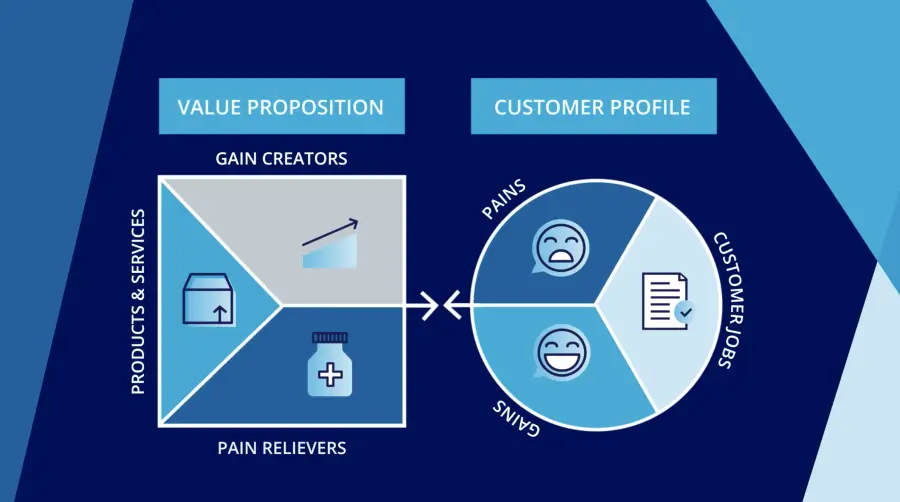Exploring the Significance of the Value Proposition Canvas
The Value Proposition Canvas serves as a vital business model instrument, enabling companies to align their products or services with the values and needs of customers. It was developed by Alexander Osterwalder, Yves Pigneur, and Alan Smith, who are also the authors of the Business Model Canvas.
The objective of this tool is to examine and map the value that customers perceive. Its primary aim is to establish a strong connexion between the product and the market. To achieve this, the Value Proposition Canvas delves deeper into two specific blocks from the Business Model Canvas: Customer Segment and Value Proposition.
Value Proposition Canvas Explained

Originally conceptualised by Dr Alexander Osterwalder, the Value Proposition Canvas was created as a comprehensive framework to guarantee the alignment between a product and its target market. This tool provides a detailed approach to model the interconnection between two fundamental components of Osterwalder’s broader Business Model Canvas: customer segments and value propositions.
What Are The Benefits of Using the Value Proposition Canvas?
The Value Proposition Canvas plays a vital role in shaping a business model by aiding in decision-making and product positioning. It goes beyond being a mere visual depiction of customer desires, as it empowers businesses to align their strategies with the specific needs of their customers.
By utilising the Value Proposition Canvas, businesses can effectively develop products that cater to the desires of their target audience. Now, let’s explore the key advantages that the Value Proposition Canvas offers.
Focused Planning
In the fast-paced world of constant idea generation, it’s all too easy to lose sight of the core values that drive success. Consequently, the final product often falls short of meeting customer expectations, which is far from desirable.
However, by employing a Value Proposition Canvas, you can maintain a clear and focused path. Acting as a visual guide, this tool ensures a targeted approach to product development, helping you create a high-demand offering that aligns with customer needs and desires.
Improves Marketing Outreach
The successful launch of a new product requires significant investment in marketing and branding efforts. It involves effectively communicating to customers how purchasing the product can fulfil their needs. This strategic approach helps establish a robust brand image within the minds of consumers.
Consequently, customers begin to associate the brand with exceptional quality and service. In this context, the Value Proposition Canvas emerges as a valuable tool. By identifying customer needs and developing a well-defined action plan, it enables seamless promotion and advertisement activities that effortlessly capture customer attention.
Strong Customer Involvement
To effectively engage customers with your brand and product, customer orientation is paramount. By adopting this approach, product development places the utmost importance on customer satisfaction.
A Value Proposition Canvas serves as the crucial link between identifying customer needs and fulfilling them. The advantage of utilising this framework is its ability to concentrate on the elements that hold the highest value for customers. As a result, it fosters a strong sense of customer involvement, ultimately strengthening the bond between your business and its target audience.
Practical and Simple
The Customer Value Canvas provides a streamlined overview of a business’s functionality. It simplifies the analysis of product strategy and performance, making it both comprehensive and easy to understand.
When is the Value Proposition Canvas Not Useful?

In fact, the tool itself does not possess any inherent features that can be considered as disadvantages. Any potential harm that may arise from using the canvas is solely dependent on its improper usage. Here are some examples of issues that can arise when using the VPC.
Loss of Canvas Distinction
The tool comprises two distinct parts, as we have previously discussed. Although they are interconnected, each part functions as a separate unit. The most significant mistake one can make when using the canvas is failing to differentiate these parts and treating them as a singular entity.
It is essential to recognise that the components differ from one another. The elements on the right side are external factors beyond your control, while those on the left side represent aspects that you can actively change or enhance.
Overloading with Customer Segments
It is possible to narrow down the customer segment based of the VPC on factors such as age, social status, interests, and more. In such cases, it is advisable to fill in separate canvases for each category of users. One significant mistake to avoid is mixing all customer segments into a single chart. This approach makes it challenging to identify the highest priority jobs, pains, and gains for each segment. Consequently, the left part of the canvas may lose focus, leading to a decline in the perceived value of your product.
Improper Way of Filling
The order in which you fill in the value map is indeed significant, and the approach you take is crucial. When filling it from right to left, you determine the essential values your product should possess to meet the demands of the market. On the contrary, if you approach it from left to right, you may struggle to truly comprehend what customers genuinely require. It’s important to recognise that the right part of the canvas operates independently from the left part, which focuses on achieving the highest possible alignment with the customer’s profile and issues.
When to use Value Proposition Canvas?
In essence, the Value Proposition Canvas serves as a valuable tool to immerse yourself in your customers’ perspective and comprehend their world. As mentioned earlier, the ultimate objective is to achieve your Product Market Fit by aligning your products or services with the needs, expectations, and interests of your targeted customers.
By utilising the Value Proposition Canvas, you gain a comprehensive overview of how your value proposition will impact your customers’ lives. The product-market fit is attained when your offerings closely match the most crucial gains and pains of your customer profile.
It’s important to note that completing the Value Proposition Canvas is only the initial phase as it’s crucial to validate the hypotheses by conducting tests and gathering feedback. This iterative process allows for refining and enhancing the canvas.
Furthermore, it’s worth emphasising that the Value Proposition Canvas does not replace the Business Model Canvas; they complement each other when used together. One does not exclude the other; they work synergistically to provide a comprehensive understanding of your business model and value proposition.
What does a Value Proposition Canvas Contain?

As previously mentioned, the Value Proposition Canvas consists of two essential blocks: Value Proposition and Customer Segment. These blocks form the core of the business model as they address the fundamental questions of “What” and “To whom.” In other words, they focus on how your company delivers value to your target audience.
The canvas is divided into two sides. On the right side, we have the Customer Profile, which is further divided into three components: Jobs-to-be-done, Pains, and Gains. On the left side, we find the Value Proposition, which is also subdivided into three elements: Products & Services, Gain Creators, and Pain Relievers. Let’s explore each of these components in more detail.
Client Profile
Jobs-to-be-done
This step revolves around understanding the tasks your customers are attempting to accomplish. It is crucial to encompass all the tasks they are trying to perform, the problems they aim to solve, and the needs they seek to fulfil. Additionally, it is important to consider the frequency and significance of each job, as well as the various roles your customers may have to play and the contexts in which they operate. To effectively complete this step, you can ask yourself the following questions:
- What functional tasks is my customer trying to perform? (e.g., day-to-day tasks, work-related challenges, etc.)
- Which social tasks is my customer striving to achieve? (e.g., securing a promotion, gaining status, building a network, etc.)
- What emotional tasks is my customer seeking to fulfil? (e.g., getting in shape, feeling good, staying motivated, etc.)
- Which basic needs do they want or need to have satisfied? (e.g., communication, hygiene, etc.)
By answering these questions, you can gain a comprehensive understanding of the tasks, problems, and needs of your customers, allowing you to tailor your value proposition accordingly.
Pains
This step involves identifying all the pain points and challenges that your customers experience while performing their jobs to be done. These can include negative experiences, emotions, obstacles, risks, financial costs, mistakes, and consequences. It is important to classify each pain as either severe or mild and note the frequency at which they occur. To complete this step, you can ask yourself the following questions:
- Which aspects are expensive for my customer in terms of time, cost, or effort?
- What causes negative emotions or feelings of frustration, disappointment, failure, or physical pain for my customer?
- Which are the primary difficulties and challenges my customers face, whether they are physical, intellectual, or emotional limitations?
- How do current solutions fall short and fail to meet the expectations and needs of my customers in terms of performance, effort, functionality, or defects?
- What are the negative consequences experienced by my customers, such as loss of power, status, money, time, or trust?
- What are the risks that my customers fear, whether they are financial, social, technical, or otherwise?
- Which concerns keep my customers awake at night, including challenges, debts, or health issues?
- What are the most common mistakes made by my customers, such as having unrealistic expectations, misunderstandings, or errors in product use?
- Which factors are preventing my customers from adopting solutions, whether it’s the required investment, learning curve, or resistance to change?
By addressing these questions, you can gain insights into the pain points and challenges faced by your customers, enabling you to develop effective solutions that alleviate their pains and enhance their overall experience.
Gains
These are the benefits that your customers expect, desire, or even those that would pleasantly surprise them. These benefits can be functional, emotional, social, or financial in nature, encompassing everything that brings them delight and improves their lives by making them easier, more joyful, or more successful. It is helpful to rank each gain by relevance and indicate their frequency. To achieve this, you can consider the following questions:
- What types of savings would bring happiness to my customers? (time, money, energy, etc.)
- What results do my customers expect? Which results have the potential to captivate and fascinate them? (quality levels, profits, savings, improvements, etc.)
- Which solutions enchant my customers? (functionalities, performance, quality, etc.)
- How can I make my customers’ tasks easier? (reducing the learning curve, providing additional services, lowering costs, etc.)
- What positive consequences do my customers desire? (power, status, recognition, satisfaction, motivation, etc.)
- What features or attributes are my customers seeking? (design, guarantees, specific functionalities, etc.)
- How do my customers measure success and failure? (cost, performance, speed, quality, aesthetic appeal, social media likes, etc.)
What factors would increase my customers’ likelihood of adopting a solution? (lower investment, extended warranty, improved performance, quality, or design, etc.)It is important to create a distinct profile for each customer segment. Once you have mapped your customers’ profiles, the next step is to determine the value they will perceive from your product or service.
Value Proposition
Products & Services
Ensure that you include all the products and services you intend to offer. For each offering, consider the following questions:
- Can the product or service assist in accomplishing any job to be done, whether it is functional, social, emotional, addressing needs, fulfilling wishes, or playing specific roles, etc.?
- Is the product or service tangible, digital/virtual, or financial in nature?
- Is the product or service essential or trivial? How significant is its relevance?
- How frequently will the product or service be used by your customers?
By addressing these questions, you can evaluate the potential of each product or service, understand its role in fulfilling customer needs and desires, determine its form (tangible, digital/virtual, or financial), assess its relevance and importance, and gauge its anticipated usage frequency. This analysis allows you to align your offerings effectively with the specific requirements and preferences of your target customers.
Gain Creators
Consider how your product or service provides added value to the customer, what benefits it brings, and whether it meets their wishes and expectations, ultimately contributing to their happiness. Once again, it is important to rank each gain your product or service offers in terms of relevance to your customers, indicating its frequency of occurrence. To accomplish this, ask yourself the following:
- Does your product or service create savings that bring happiness to your customers, such as saving time, money, or effort?
- How does it generate results that meet or exceed your customers’ expectations, delivering a higher level of quality, quantity, or less of a specific aspect?
- Does it replicate or outperform existing offerings that already delight your customers in terms of specific functionalities, performance, or quality?
- Does it make your customers’ tasks or life easier, providing a lower learning curve, improved usability, accessibility, additional built-in services, or reduced cost of ownership?
- Will it create positive social consequences desired by your customers, enhancing their image, power, or status?
- Does it possess features or attributes that your customers actively seek, such as appealing design or specific functionalities?
- Will it help fulfil your customers’ dreams, assisting with significant goals or providing substantial relief?
- Does it produce positive outcomes that align with your customers’ criteria of success or failure, such as improved performance or lower costs?
- Will it make adoption easier for your customers, by reducing costs, lowering investments, minimising risks, or offering higher quality, performance, or design?
By evaluating these aspects, you can determine how your product or service delivers value, meets customer expectations, and brings about happiness. Rank each gain according to its significance to your customers and indicate the frequency at which it occurs. This analysis allows you to tailor your offerings to maximise customer satisfaction and ensure a strong value proposition.
Pain Relievers
Describe how your product or service alleviates the pains experienced by your customers. Identify if it reduces their costs, negative emotions, efforts, risks, negative consequences, mistakes, and any other factors that negatively impact them. In essence, focus on how your offering improves their overall well-being and peace of mind.
Furthermore, it is crucial to rank each pain based on its intensity to better understand the extent to which your product or service helps your customers. To guide you in this process, consider if your product or service:
- Generates savings in terms of time, money, effort, and other resources.
- Enhances your customer’s well-being by addressing frustrations, discomforts, or headaches.
- Provides improved solutions, such as new features, better performance, or higher quality.
- Mitigates the difficulties and challenges faced by your customers, making tasks easier and eliminating resistance.
- Eliminates or mitigates social consequences that may lead to the loss of respect, admiration, power, confidence, or status.
- Reduces or eliminates the risks that your customers fear, whether they are financial, social, technical, or any other potential pitfalls.
- Helps your customers sleep better at night by addressing major problems and reducing worries.
- Prevents or minimises common mistakes made by your customers, offering ease of use and reducing difficulties.
- Removes barriers that hinder your customers from adopting new solutions.
- By addressing these points, you can effectively articulate how your product or service addresses the pain points and concerns of your customers, offering them relief, peace of mind, and an overall better experience. Rank each pain according to its severity to gain a deeper understanding of the impact your product or service has on customer satisfaction.
How Do I Use A Value Proposition Canvas?

- Select a specific customer segment that you want to focus on.
- Identify the various jobs that this customer segment needs to accomplish and prioritise them based on their importance to the customers.
- List the pains or challenges that the customers face while performing these jobs and prioritise them.
- Identify the gains or desired outcomes that the customers seek and prioritise them.
- Choose the top 3-5 most critical pains and gains that are directly related to the most important jobs.
- List all the benefits that your product or service offers to the customers.
- Identify all of the pain relievers, i.e., the features or aspects of your offering that address and alleviate the customer’s pains.
- List the gain creators, i.e., the features or aspects of your offering that provide the desired outcomes and fulfil the customer’s gains.
- Select the 3-5 gain creators and pain relievers that have the most significant impact on the customer’s experience.
- Establish clear connexions between the pain relievers, gain creators, and the benefits of your product or service with the corresponding pains, gains, and jobs they address.
- Define how your offering stands out and outperforms the competition, highlighting your unique advantages.
- Develop value propositions that are clear, easily understandable, and free of jargon. These value propositions should foster trust and resonate with your customers.
- Test your value proposition(s) with your customers to gather feedback and validate their effectiveness.
By following these steps, you can create a well-defined value proposition that directly addresses the needs, pains, and desired outcomes of your chosen customer segment, distinguishing your offering from the competition and building strong trust and rapport with your customers.
Value Proposition Canvas Tips
View Each Component Distinctly
The components of the Value Proposition Canvas are distinct but interconnected. The Customer Profile focuses on understanding the needs and desires of the customers, while the Value Map integrates these key insights to enhance product quality. It is the responsibility of the business to transform the final product into something that aligns with the desires of the customers. To accomplish this, it is crucial to prioritise and address the specific requirements of the customers, ensuring that the product meets their expectations and delivers value.
Deal With Every Customer Segment
One of the most common mistakes made by businesses is treating all customer segments as one entity, neglecting the distinct jobs, pains, and gains of each segment. This approach makes it challenging for businesses to effectively identify and address the specific needs of their target segments.
A valuable tip is to create separate Customer Profiles for each customer segment. This enables businesses to develop tailored value propositions for each segment individually, making it easier to select a specific customer segment to focus on. By recognising the unique characteristics and requirements of different customer segments, businesses can enhance their targeting and marketing strategies, ultimately improving their overall success.
Think like a customer
Creating an effective customer profile requires capturing the jobs, pains, and gains that customers aspire to achieve. Unfortunately, many businesses often draught customer profiles inefficiently, failing to focus on customers’ expectations and solely focusing on the problem their product or service aims to solve. To overcome this challenge, a helpful approach is to encourage the entire team to switch roles and imagine themselves as customers.
By considering their daily activities, destinations, and tools they utilise, the team can gain valuable insights into customer perspectives. Adopting a customer mindset enables the identification of product deficiencies and highlights the driving factors behind customer purchases. Essential customer needs that must be met can be uncovered by utilising problem-solving tools like the Five Whys technique. By approaching customer profiles with this empathetic and problem-solving mindset, businesses can better align their products and services with customer expectations and enhance overall customer satisfaction.
Evaluate Jobs-To-Be-Done
Understanding the “job to be done” of your customers is essential for crafting a compelling value proposition that sets your product apart. This factor plays a significant role in determining the level of desire for one product over another. While functional jobs may appear to be the primary reasons for purchase, the level of satisfaction derived from them tends to be relatively low. Conversely, emotional and social jobs provide a higher degree of personal satisfaction. With this in mind, it is advisable to plan and develop a product or service that addresses the social and emotional aspects of your customers’ needs. By catering to these deeper, more meaningful dimensions, you can create a more successful value proposition that resonates with your target audience and fosters strong customer satisfaction.
Focus on What Customers Need The Most
When creating the Value Proposition Map, it is important to consider the following points. Firstly, it is not feasible to address all customer pains and gains. Instead, it is advisable to prioritise the key factors that customers deem as their highest priorities. By targeting these essential elements, your team can set clear goals and concentrate their efforts on developing a product that effectively addresses these critical customer needs. This approach ensures a focused and targeted development process that increases the likelihood of creating a successful and impactful product.
The 5 Mistakes To Avoid When Making a Value Proposition Canvas

Not Looking at the Value Proposition Canvas as Two Separate Building Blocks
Many individuals struggle to differentiate between jobs, pains, and gains, as well as between pains and pain relievers, or gains and gain creators. This confusion often stems from a lack of understanding of the customer and a tendency to generalise the benefits of a value proposition. To overcome this challenge, it is crucial to perceive the Value Proposition Canvas as comprising two distinct elements or building blocks.
On the right-hand side of the canvas (the circle), we have the ‘Customer Profile.’ This circle encompasses only the observable aspects of a customer segment, all of which are beyond your direct control. It is essential to recognise that these elements are external factors that shape the customer’s experience.
On the left-hand side of the canvas (the square), we find the ‘Value Map.’ This square represents the components that you will design into your value proposition to address the jobs, pains, and gains of the target customer segment. These are the elements that fall within your realm of control, allowing you to shape and optimise the value delivered to customers.
By understanding this distinction and clarifying the separation between the Customer Profile and Value Map, you can effectively develop a value proposition that aligns with customer needs and create a stronger impact with your product or service.
Mixing Several Customer Segments into One Canvas
It is a common error to see companies combining the jobs, pains, and gains of different customer segments into a single Customer Profile on the canvas, such as grouping payers and users together. However, this approach is incorrect because each distinct customer segment has its own unique set of jobs, pains, and gains. Mixing multiple segments together creates confusion and makes it challenging to identify which segment’s attributes are being observed. It also hinders the ability to prioritise and address the highest priority jobs, pains, and gains, resulting in a less effective value proposition.
To rectify this mistake, it is recommended to work through the Customer Profile one customer segment at a time. By completing each Customer Profile separately, you can gain a clearer understanding of the specific needs and preferences of each segment. This approach allows for the design of tailored value propositions that cater to the distinct requirements of each customer segment.
During working sessions with companies, it is often helpful to hang multiple Value Proposition Canvases on a wall, allocating each customer segment to its own canvas. Alternatively, digital tools like Strategyzer’s web app can be used to create and manage multiple Value Proposition Canvases efficiently.
By adopting a segmented approach and treating each customer segment individually, businesses can ensure a more accurate and targeted understanding of customer needs, leading to the development of compelling value propositions that resonate with each specific segment.
Creating your Customer Profile Through the Lens of Your Value Proposition
One common challenge I frequently encounter when working with clients, whether in large companies or startups, is the difficulty people face in detaching themselves from their own ideas, products, services, or technologies. This often leads to a narrow focus when filling in the Customer Profile, where they only consider the jobs, pains, and gains that they believe their value proposition can resolve. As a result, they overlook the genuine needs of their customer segments and the underlying motivations that drive their behaviours.
To overcome this issue, it is crucial to step into your customers’ shoes and adopt an anthropological mindset. Take a moment to set aside your own offerings and aspirations. Instead, seek to understand beyond the specific jobs, pains, and gains you aim to address with your value proposition. Look deeper into the motivations that truly influence customer behaviour. A valuable technique in this process is the “Five Whys” approach, which helps uncover the underlying drivers that lead customers to perform certain jobs, avoid specific pains, and pursue particular gains.
By embracing this customer-centric perspective and exploring the deeper motivations behind their actions, you can gain valuable insights that enable the creation of a more impactful and resonant value proposition. This shift in mindset allows you to better understand and cater to the genuine needs of your customer segments, leading to more effective product development and improved customer satisfaction.
Only Focusing on Functional Jobs
After completing the initial Customer Profile, it is beneficial to engage in an exercise where customers’ jobs are categorised as functional, social, or emotional in nature. Often, we observe that the majority of identified jobs tend to be functional, as they are more visibly apparent. However, it is crucial to challenge yourself to look beyond the obvious functional jobs and delve into the social and emotional dimensions that drive customer behaviour.
By exploring the social and emotional aspects, you can uncover motivations such as the desire to impress bosses, coworkers, friends, or family members, which may influence customers’ choices in driving specific cars or wearing particular clothing. Additionally, customers may seek to improve their self-perception by engaging in activities like maintaining a healthy diet or spending quality time with others. The pains associated with social or emotional jobs are often deeply felt, while the gains sought after in these areas are typically pursued with great intensity.
By expanding your understanding of customers’ social and emotional jobs, you can gain deeper insights into their motivations and develop a more comprehensive value proposition. This broader perspective allows you to address the pains and fulfil the gains associated with these dimensions, resulting in a more resonant and impactful offering that meets the holistic needs of your customers.
Trying to Address Every Customer Pain and Gain
It is quite common to witness individuals attempting to connect every job, pain, and gain from the Customer Profile to the products, services, pain relievers, and gain creators on the Value Proposition Map. However, it is unrealistic to believe that you can satisfy all of these aspects for your customers. Moreover, investing time and effort in such a scattered approach leads to a lack of focus, resulting in unsatisfactory outcomes across the board. Ultimately, this leaves your customers unsatisfied.
Instead, it is crucial to acknowledge that the most effective value propositions primarily focus on addressing the highest priority jobs, pains, and gains of your customers. It is essential to make deliberate tradeoffs and choose which jobs, pains, and gains you will prioritise and which you may need to overlook. By doing so, you can concentrate your efforts on delivering exceptional performance in the specific elements you choose to address, ensuring customer satisfaction in those crucial areas.
By aligning your value proposition with the most important customer needs and making thoughtful decisions about what to prioritise, you can create a more impactful and focused offering. This approach allows you to excel in the areas that truly matter to your customers, leading to higher customer satisfaction and a stronger competitive advantage.
Value Proposition Canvas Templates
Free PDF Value Proposition Canvas Template
You can access the free value proposition canvas template for download at this link. This template provides a blank canvas that you can fill in with your specific information and details.
Miro Value Proposition Canvas Template
If you’re a fan of Miro, you’ll be delighted to find this free Miro value proposition canvas template. It’s specifically designed to work seamlessly within the Miro platform, allowing you to easily collaborate and fill in the template with your unique value proposition details.
FAQs
How to Summarise Value Proposition Canvas?
A compelling value proposition effectively communicates how a product addresses a customer’s needs, articulates its unique benefits, and highlights its superiority compared to similar products in the market. The best value propositions are concise, straightforward, and resonate with the customer’s primary decision-making factors.
What is the Most Important Thing To Understand From a Value Proposition Canvas?
A value proposition assists in gaining a deeper understanding of your customers and devising effective strategies to position your products or services to attract them. There are various approaches to crafting a value proposition, but the key factor is ensuring it is customer-centric and addresses their specific pain points. By prioritising the customer’s needs and challenges, you can develop a value proposition that resonates with them and offers compelling solutions.
What are the 6 Components of a Value Proposition Map?
The Value Proposition Canvas emphasises six key components: customer jobs, customer pains, customer gains, your products & services, pain relievers, and gain creators. These elements play a vital role in understanding and developing a comprehensive value proposition for your business.
What first, value proposition or business model canvas?
While there is no strict order or prescribed approach for using the Business Model Canvas (BMC) and the Value Proposition Canvas (VPC), a common practice is to begin with the VPC to define and validate your value proposition, followed by utilising the BMC to shape and validate your business model around it. The VPC serves as a valuable tool for conducting customer interviews, surveys, experiments, and other methods to verify your assumptions about customer needs and the value you offer. On the other hand, the BMC allows you to map out your current or desired business model and test your hypotheses regarding revenue streams, cost structure, channels, partners, and other aspects of your business. Additionally, the BMC and VPC can be used to compare and contrast different business model options or scenarios, enabling you to iterate and pivot based on feedback and insights gained through the process.
Overview
Now that you understand how to create a value proposition canvas, have a look at how to set your pricing strategy to get the most customers and how to refine your business model in light of your findings.







